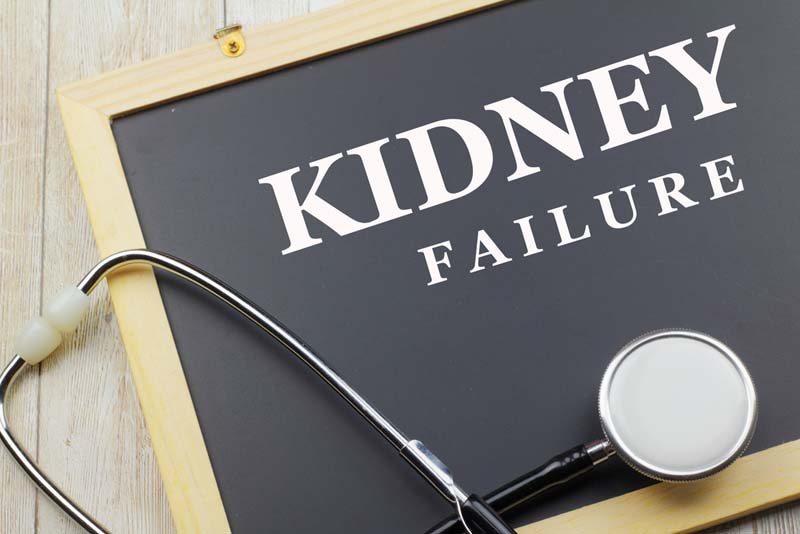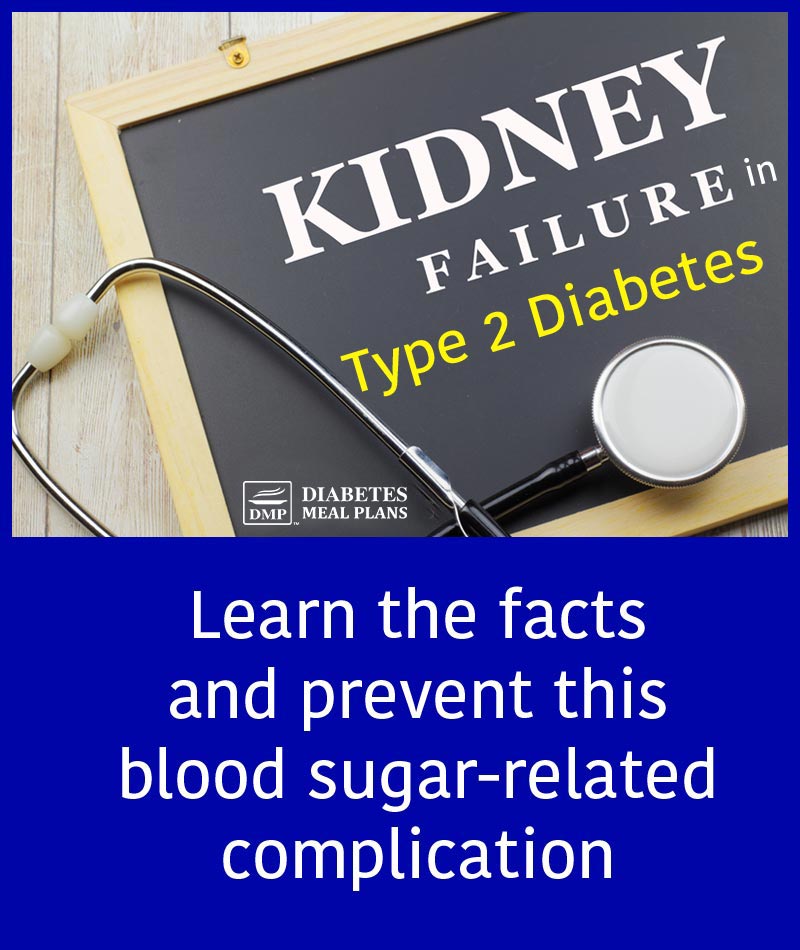Kidney failure is a real risk in type 2 diabetes, which is why it’s better to be informed about how the condition develops and it’s consequences – some of which can be life-threatening.
It does pay to take action in controlling your blood sugar levels and look after your health because as you’ll soon find out, the cause of kidney failure is largely preventable.

What is Kidney Disease?
Nephropathy (or kidney disease, also known as “renal disease”) is one of the many diabetic complications that can occur as a result of chronically elevated blood sugars.
Remember that complications associated with diabetes are the result of excess sugar in the blood – it’s the high glucose levels that cause damage to the cells and organs your blood feeds, which happens to be all of them.
The kidneys are just one such organ. However, the kidneys play such an important role in filtering the blood, which means they are especially at risk.
The main purpose of the kidneys is to filter the blood. When waste enters the bloodstream either through environmental toxins or as byproducts of metabolism, the kidneys effectively filter out the stuff that needs to stay from the stuff that needs to go. The stuff that needs to go then gets transferred to the bladder and you can picture the rest!
Picture how a coffee filter works – you add the grounds and hot water is brewed over them and you end up with a delicious morning beverage. Now think about what would happen if that filter wasn’t working correctly, perhaps it had some decent sized holes in it. What would happen when you brewed your coffee?
Bingo – grounds in the coffee and a very gritty beverage…yuck!
The same sort of thing can happen to your kidneys over time. If they are sufficiently damaged by excess glucose (remember the JOB of the kidneys is to filter blood and if you have high blood sugar this is constantly traveling through all the blood vessels of the kidneys gradually damaging them), you are going to end up with the good stuff being eliminated in the urine and the bad stuff staying in your bloodstream.
If you’ve ever heard of the test “BUN” this stands for “Blood Urea Nitrogen.” Urea and nitrogen are waste products that should be filtered out in the urine so when we detect large amounts of it in the bloodstream we know there is a problem.
Symptoms and Tests for Kidney Disease
Aside from the BUN test, there are a couple of other tests you should have annually to detect potential kidney problems. The most common one is “microalbumin.”
Albumin is a protein that is supposed to stay in the body. However, with poor kidney function this is often filtered out in the urine and when small (micro) or large (macro) amounts are detected, it indicates kidney damage.
Another indication that kidneys may be damaged is swelling, especially in the feet and ankles, high blood pressure, and increased need to use the bathroom overnight. Keep in mind that in early stages of kidney disease there are often no signs, which is why it is very important to have the blood tests done annually.
As damage progresses, toxins in the blood will continue to accumulate leading to fatigue, weakness, muscle cramps, anemia, nausea, vomiting, and itching. NOTE: all of these can be symptoms of other problems as well. If you are experiencing any of these symptoms, schedule an appointment with your primary care doctor for proper diagnosis.
Kidney Disease Stages
There are several stages of kidney disease depending on how well the kidneys are able to filter the blood. This is known as “glomerular filtration rate” or “GFR.”
Stage 1 is GFR >90
Stage 2 is GFR 60-89
Stage 3 is GFR 30-59
Stage 4 is GFR 15-29
Stage 5 is GFR <15
As you can see the higher numbers indicate less severity. The early stages indicate the kidneys are still able to filter high rates of blood effectively. As the disease progresses to kidney failure (stage 3 and beyond), more severe kidney damage is evident. Stage 5 kidney disease requires dialysis to survive (see below).
In addition to high blood sugar causing problems with filtering in the kidneys, it causes nerve damage (neuropathy) to tissues, including the bladder. This can result in difficulty emptying the bladder (increasing risk of bladder infection) and an eventual buildup of pressure, which can back up to the kidneys, further injuring them.

Kidney Failure: Need to Know Facts
If you do have kidney disease, early treatment is your best shot at stopping or reversing damage. You will be referred to a nephrologist who will probably prescribe medications based on your particular condition.
Certain blood pressure medications known as ACE-inhibitors are effective at slowing rate of kidney disease. You will be advised to follow a healthy diet and do everything you possibly can to keep your blood sugars under control to prevent further kidney damage.
You will also want to review all of your medications with your doctors and pharmacists, since some of them are cleared by the kidneys, they may not work as well or become toxic if not eliminated.
Stages 1 and 2
Unfortunately, many practitioners do not make a big deal of stages 1 and 2, which are the when a person has the best shot at halting or slowing the process. So if you fall in this category, take it upon yourself to take action in controlling blood sugar levels.
Stage 3 and 4
Once stage 3 is reached, there is significant kidney impairment and additional dietary measures are required. For instance, cutting back on healthy nutrients such as protein, phosphorous, potassium (this means a lot of fruits, vegetables, and lean meats) is required because the kidneys can’t sufficiently filter them.
This becomes very problematic because these are the very foods that should comprise the bulk of a diet for diabetes and healthy blood sugar control. The further kidney disease progresses, the more restrictive diet measures must be, to the degree that people will have to limit tomatoes, spinach, dairy, salmon and even water!
That’s right kidneys filter fluids and so later stages of disease results in swelling from fluid retention, if not restricted.
Stage 5
End stage renal disease (ESRD) is stage 5. A person at this stage will not be able to sustain life much longer without serious intervention.
Dialysis involves being hooked up to a machine, which removes a person’s blood, filters it, and then infuses it back into them through a shunt in several cycles. Most people on dialysis have to go in to get dialyzed, 3 or more times weekly, for several hours at a time. Alternatively, people can get on a list for a kidney transplant, though there is often a long wait and not everyone on the list will be able to obtain one. Additionally, there is no guarantee that a donor match will work correctly in the recipient.
Conclusion
To sum up, kidney disease is extremely serious but largely preventable.
Diabetes is the leading cause of kidney disease and tight blood sugar control is the best way to prevent or slow the damage.
Blood sugar can be controlled through diet, exercise, medications, stress management, getting enough sleep and regular preventative care, including lab tests ordered by your doctor.
Don’t be complacent. Diabetes can be life-threatening. So do what you can to stay healthy and prevent these complications.
Please pin, tweet or share this info to help others. Thanks!

Ella
Ella good to read that info,am learning to keep my diet in tac. and eat right excercise and monitor what I eat, thank God everything is improving as long with my blood pressure, what do you recommend for that,to be able to do alternative treatment as far as a lot of blood pressure drugs,if it’s alright for you to say
Emily - Dietitian (MS, RD)
We have written about blood pressure over here. Like you are already seeing, the same diet/lifestyle that helps with your blood sugar is going to also help with blood pressure management. Keep staying diligent!
jon
That”s good information.
jim
Excellent article! I think I have read it four times now and although I am typing I’m still debating if I want to respond. In 1995 my mother passed in just the manner you described. Her life was complicated by a stroke but I suppose even that could have been type 2 related. Back then I don’t think many practitioners were pushing the food choices you are. I wonder now if the whole food approach would have helped her. I feel so frustrated (note trying not to be mad at myself) that I didn’t pay more attention and get a grip years and years ago.
I think the tone of this is about as serious as I’ve read here. I’m not sure it will generate much discussion. I do hope everyone reads it because you are writing to everyone of us.
Elizabeth
Thanks Jim–I agree it is very serious and has gone untreated in the past. However, keep in mind that the screening, education and treatment has come such a long way because we’ve LEARNED so much through research and study. It wasn’t the case that physicians were intentionally overlooking in the past or being lazy. They simply didn’t have the information we now do. Doctors used to advise their patients to smoke! We’ve come a long way in our understanding of chronic disease (another ‘newer’ problem as people are living longer than they used to). We all have 20/20 hindsight and sometimes those things we wished we’d done differently can be our most powerful motivators for what we’re going to do NOW. Each one of us can make smart decisions where we are today and I know you will!